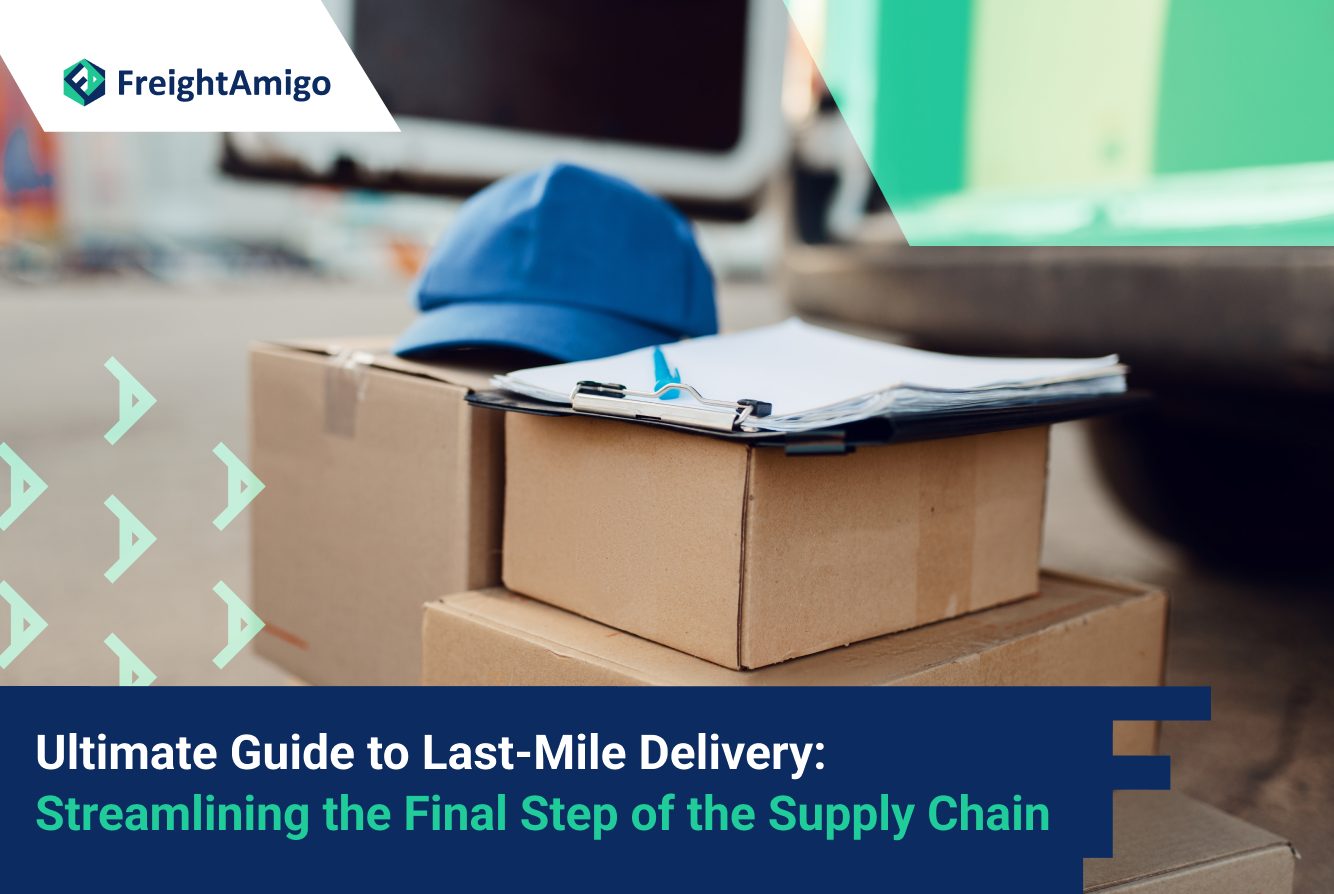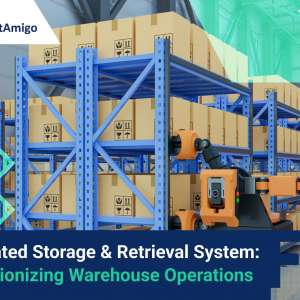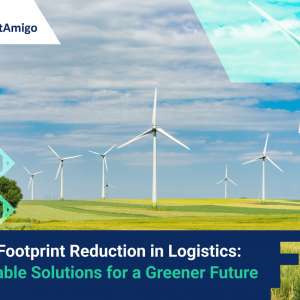Author Name: Tiffany Lee – Marketing Analyst at FreightAmigo
In the world of supply chain logistics, the last mile of delivery is often the most critical and complex. It refers to the final leg of the delivery process, where goods are transported from a distribution center or fulfillment center to their ultimate destination—the customer’s doorstep. Last-mile delivery plays a pivotal role in customer satisfaction and can make or break a company’s reputation. In this comprehensive guide, we will explore the intricacies of last-mile delivery, its challenges, and innovative solutions to optimize this crucial step in the supply chain.
Want To Compare The Best Express, Air Freight, Sea Freight, Rail Freight & Trucking Rates So As To Have Better Control On Cost?
1. Introduction to Last-Mile Delivery
Last-mile delivery is the final stage of the supply chain, where products are transported from a distribution center or fulfillment center to the end customer’s location. It is often considered the most intricate and expensive part of the delivery process, as it involves navigating complex urban environments, ensuring timely deliveries, and meeting customer expectations. Successful last-mile delivery requires effective coordination, efficient route planning, and seamless communication between all stakeholders involved.
2. The Importance of Last-Mile Delivery
Last-mile delivery is a critical touchpoint in the customer experience journey. It is the moment when the customer finally receives their long-awaited purchase, and their satisfaction depends on the efficiency and quality of the delivery process. A smooth last-mile delivery can leave a positive impression, leading to customer loyalty, positive reviews, and word-of-mouth recommendations. On the other hand, a poor delivery experience can result in customer dissatisfaction, negative feedback, and potential loss of business.
3.Challenges in Last-Mile Delivery
Last-mile delivery faces numerous challenges that can hinder its efficiency and profitability. Some of the key challenges include:
Traffic Congestion and Urbanization
As urban areas continue to grow, traffic congestion becomes a major obstacle for last-mile delivery. Navigating through crowded streets and dealing with limited parking spaces can significantly delay deliveries and increase operational costs. Urbanization also poses challenges in terms of access to certain areas, such as gated communities or high-rise buildings.
Delivery Time Windows and Customer Expectations
Customers have increasingly high expectations when it comes to delivery speed and flexibility. They demand shorter delivery time windows, same-day or next-day delivery options, and the ability to track their orders in real-time. Meeting these expectations requires streamlined operations, efficient logistics, and advanced technology solutions.
Cost and Efficiency
Last-mile delivery can be costly due to factors such as fuel expenses, labor costs, and vehicle maintenance. Optimizing delivery routes, reducing empty miles, and implementing efficient resource allocation can help mitigate these costs. However, achieving cost-efficiency while maintaining service quality remains a challenge for many companies.
Delivery Flexibility and Returns
Customers expect delivery options that match their busy lifestyles. They want the flexibility to choose specific time slots, reroute packages, or have packages delivered to alternative locations. Additionally, the handling of returns and reverse logistics adds complexity to the last-mile delivery process and requires efficient systems to manage.
4. Technology Solutions for Last-Mile Delivery
To overcome the challenges in last-mile delivery, companies are turning to innovative technology solutions. These solutions aim to optimize routes, improve visibility, enhance customer communication, and automate various aspects of the delivery process. Here are some key technology solutions for last-mile delivery:
Route Optimization Software
Route optimization software uses algorithms to determine the most efficient delivery routes, taking into account factors such as traffic conditions, delivery time windows, and package volumes. By optimizing routes, companies can reduce travel distances, minimize fuel consumption, and improve overall delivery efficiency.
Real-Time Tracking and Visibility
Real-time tracking and visibility solutions enable businesses and customers to track shipments and receive timely updates on their delivery status. This technology provides transparency and enhances customer satisfaction by allowing them to plan their day accordingly and have peace of mind knowing when their package will arrive.
Delivery Drones and Robots
Unmanned aerial vehicles (UAVs), or drones, have the potential to revolutionize last-mile delivery by offering fast and flexible delivery options, especially in remote or hard-to-reach areas. Similarly, autonomous delivery robots can navigate sidewalks and streets to make efficient and contactless deliveries. These technologies reduce delivery times, minimize human error, and improve the overall customer experience.
Lockers and Pickup Points
Lockers and pickup points provide convenient alternatives for customers to collect their packages at their own convenience. These self-service options are often located in easily accessible locations such as shopping centers, train stations, or residential buildings. They eliminate the need for home deliveries, reduce the risk of missed deliveries, and improve overall operational efficiency.
5. Collaborating with Last-Mile Delivery Providers
Collaboration with reliable last-mile delivery providers is crucial for businesses looking to optimize their delivery operations. FreightAmigo, a leading logistics platform, specializes in collaborating with last-mile delivery providers to ensure efficient and seamless delivery of goods to end customers. By integrating their logistics platform with last-mile delivery systems, FreightAmigo enables smooth coordination and data exchange, resulting in a more streamlined and cost-effective last-mile delivery process.
Integration with Logistics Platforms
FreightAmigo’s integration capabilities allow businesses to connect their supply chain management system with last-mile delivery systems seamlessly. This integration enables the exchange of real-time data, such as order information, delivery schedules, and customer preferences. By integrating these systems, businesses can achieve end-to-end visibility and optimize their last-mile delivery operations.
Optimizing Last-Mile Routes
FreightAmigo collaborates with last-mile delivery providers to optimize delivery routes and minimize travel distances. By leveraging advanced algorithms and data analytics, they identify the most efficient routes based on factors such as traffic conditions, package volumes, and delivery time windows. This optimization reduces fuel consumption, lowers transportation costs, and improves delivery efficiency.
Real-Time Tracking and Visibility
Through their logistics platform, FreightAmigo provides real-time tracking and visibility of shipments. Businesses and customers can track the progress of their deliveries, receive notifications, and access delivery status updates. This transparency enhances customer satisfaction and allows businesses to proactively address any issues that may arise during the last-mile delivery process.
Effective Customer Communication
FreightAmigo facilitates effective communication between businesses and customers throughout the last-mile delivery process. They provide notifications and updates, such as estimated delivery times and any potential delays. This proactive communication ensures that customers are well-informed and can plan accordingly, reducing frustration and enhancing the overall delivery experience.
Performance Monitoring and Evaluation
To ensure reliability and evaluate the performance of last-mile delivery providers, FreightAmigo monitors key metrics such as on-time delivery rates, customer satisfaction scores, and delivery accuracy. By closely monitoring these metrics, businesses can make data-driven decisions, identify areas for improvement, and maintain a high level of service quality in the last mile.
6. Benefits of Efficient Last-Mile Delivery
Efficient last-mile delivery offers numerous benefits for businesses, customers, and the overall supply chain. Some of the key benefits include:
Enhanced Customer Satisfaction
Efficient last-mile delivery plays a crucial role in customer satisfaction. By providing timely and reliable deliveries, businesses can exceed customer expectations and build a positive brand reputation. Satisfied customers are more likely to become repeat customers, recommend the brand to others, and leave positive reviews, contributing to business growth and success.
Cost Savings and Operational Efficiency
Optimizing last-mile delivery routes, reducing empty miles, and improving overall delivery efficiency can result in significant cost savings for businesses. By minimizing fuel consumption, optimizing resource allocation, and streamlining operations, businesses can achieve cost-efficiency and improve their bottom line.
Brand Reputation and Loyalty
Efficient last-mile delivery contributes to a positive brand reputation and customer loyalty. When businesses consistently deliver on time and provide a seamless delivery experience, customers develop trust and loyalty towards the brand. A strong brand reputation and loyal customer base can lead to increased market share, higher customer retention rates, and a competitive edge in the industry.
Sustainability and Environmental Impact
Efficient last-mile delivery can also have a positive impact on the environment. By optimizing routes and reducing fuel consumption, businesses can minimize their carbon footprint and contribute to sustainability efforts. Additionally, implementing alternative delivery methods such as electric vehicles or drones can further reduce emissions and promote eco-friendly delivery practices.
7. Future Trends in Last-Mile Delivery
The future of last-mile delivery holds exciting possibilities with emerging technologies and evolving consumer expectations. Here are some trends that are shaping the future of last-mile delivery:
Autonomous Vehicles and Drone Technology
The development of autonomous vehicles and drones is revolutionizing last-mile delivery. These technologies offer potential solutions for faster and more flexible deliveries, especially in densely populated urban areas. Autonomous vehicles can navigate traffic more efficiently, while drones can reach remote or hard-to-access locations, providing quick and convenient deliveries.
Micro-Fulfillment Centers
Micro-fulfillment centers, located closer to customers’ locations, are gaining popularity as they enable faster and more cost-effective last-mile delivery. These smaller warehouses are strategically positioned to reduce travel distances and enable quicker order fulfillment. By bringing the fulfillment center closer to the end customer, businesses can achieve faster delivery times and greater operational efficiency.
Blockchain and Smart Contracts
Blockchain technology and smart contracts have the potential to enhance transparency, security, and traceability in last-mile delivery. By leveraging blockchain, businesses can securely track and authenticate shipments, reducing the risk of fraud and enhancing supply chain visibility. Smart contracts enable automatic execution of delivery agreements, streamlining the contract management process and ensuring compliance.
Crowdshipping and Peer-to-Peer Delivery
Crowdshipping and peer-to-peer delivery platforms connect individuals or businesses with available delivery capacity to customers in need of last-mile delivery services. These platforms leverage the sharing economy to facilitate efficient and cost-effective deliveries. By utilizing existing resources and optimizing capacity, crowdshipping can reduce costs and improve overall delivery efficiency.
8. Conclusion
Last-mile delivery is a critical component of the supply chain, influencing customer satisfaction, operational efficiency, and brand reputation. Overcoming the challenges in last-mile delivery requires innovative technology solutions, collaboration with reliable delivery providers, and a customer-centric approach. By optimizing last-mile routes, improving visibility, and enhancing communication, businesses can achieve efficient and seamless last-mile delivery, leading to enhanced customer satisfaction, cost savings, and a competitive edge in the market. Embracing emerging trends and technologies will further drive improvements in last-mile delivery, shaping the future of logistics and supply chain management.
FreightAmigo’s last-mile delivery services play a crucial role in optimizing the final leg of the supply chain. By leveraging innovative technology, collaborating with reliable providers, and prioritizing customer satisfaction, FreightAmigo ensures efficient and seamless last-mile delivery. They optimize routes, enhance visibility, facilitate effective communication, and monitor performance, enabling businesses to achieve cost savings, enhance customer satisfaction, and stay competitive. With FreightAmigo’s expertise, businesses can overcome last-mile challenges and shape the future of logistics and supply chain management.
There Are Different Options For Cargo Transportation. If You Want To Choose The Most Convenient And Suitable Solution, It Is Best To Have The Full Support Of Logistics Experts! If You Are Planning To Ship Goods Overseas, Please Go To The FreightAmigo Page For Inquiries.
===
Read More:
【Logistic101】 What role the order fulfilment plays in a supply chain?
FreightAmigo’s Logistic Management VS Normal Logistic Management solution
Sailing Schedule: Streamlining Logistics Operations for Efficient Shipments
===
If you have any inquiries on logistics/supply chain, feel free to contact FreightAmigo now:
Chat with us online OR
Phone : +852 28121686
WhatsApp: +852 27467829









































